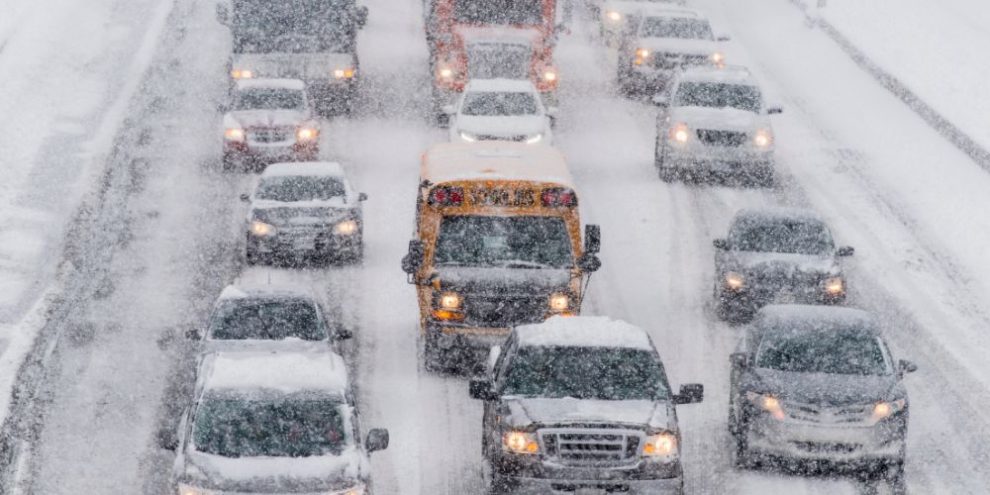
This Barrie 360 content is brought to you by Point S Action Tire
When driving in the winter, there are lots of extra hazards you need to be worried about. Snow covered roads, black ice and road spray are just a few of them. But hazards don’t just increase on the roadways. You also have to be worried about dead batteries, frozen doors and windows, engines not starting and other similar issues.
To help make your winter commute safer, consider these 5 driving tips:
1. Be Sure You Have An Emergency Car Kit
No matter the season, you should always have certain emergency items in your car. This includes items like a spare tire, jumper cables, tire pressure gauge, tow strap and reflective triangle markers. It can also include a flashlight with spare batteries, multipurpose tool, spare phone charger and basic first aid kit. Some people even have water and energy bars in their vehicle.
But when winter hits, there are some extra items you should have in your emergency car kit. Some important items are:
- Snowbrush and scraper
- Small shovel
- Sand, salt or non-clumping litter (for getting traction when stuck)
- Blanket
- Hand warmers
- A candle and waterproof matches (a lighter usually works too)
If you’re the type of person who has a tendency to leave winter clothes at home or dress lightly, be sure to keep extra layers of winter clothing in your car. You’ll be thankful you thought ahead if you get stuck in the cold.
For long commutes or travel, you may also want to pack a light overnight bag. That way you have everything you need to stay the night at a friend’s place or a hotel in bad weather.
Another winter tip is to keep deicing liquid close at hand. If you carry a purse or work bag, leave it in there. Otherwise keep a bottle near your front door and somewhere safe at work. If the locks on your car freeze up, you’ll be glad it’s there.
2. Do Some Preventative Maintenance
When it comes to winter driving tips, this is one of the most important. Making sure your car is in good condition heading into the winter will help you avoid major repairs. Not to mention long waits for tow trucks on the side of wintery roads.
Before the snow comes in, you should do a once over on your vehicle. Some important systems to have checked include:
- Defrost
- Lights
- Heater
- Wipers
- Tires
It’s also a good idea to have belts, hoses, brakes and suspensions checked and to make sure your dash lights, warnings and controls are working. This will help prevent major breakdowns while on the road.
Similarly, you want to make sure fluids are clean and topped up. This includes, but is not limited to coolant, windshield washer fluid, and oil.
RELATED: 7 signs you should get your brakes checked ...
3. Install Snow Tires
There’s a common misconception that all season tires are effective year round… After all, they’re called ALL seasons. But these tires are really only good for every season in places with mild climates. In harsh Canadian winters they’re more like 3-season tires.
That’s because the rubber in all-season tires begins to harden when temperatures drop below 7°C. This makes it harder for them to grip the road. Winter tires are designed to stay malleable in these colder temperatures. That means they have better traction and stopping power. In fact, tests show that winter tires have around 25% shorter stopping distances than all seasons.
Similarly, the tread on winter tires is designed to push away slush and snow so your tires can grip the road better.
If you want to prevent accidents during the cold season, you should consider a set of winter tires. This is especially true for drivers who live in areas with heavy snowfall, like Simcoe and Muskoka. It’s also true for people who travel on unplowed roads or roads with hard-packed snow and ice.
RELATED: 5 reasons to switch from all season tires to winters ...
4. Change Your Driving Behaviour
Before you head out, check the weather. If the conditions are too much or you don’t feel comfortable driving in them, stay home. If you have to use your car, adapt your driving to the conditions.
Start by turning on your headlights. Even if it isn’t snowing, your headlights will increase visibility and let other drivers know you are there. You also want to avoid using your cruise control. While it can be a helpful tool in warm weather, it can lead to accidents in slippery conditions especially if your car speeds up or slows down at the wrong time.
When the roads are wet, icy or snow covered, stopping and turning can also be negatively impacted. While a good set of snow tires will help reduce these problems, you still want to be careful on the roads.
Drivers are encouraged to slow down and increase the distance between them and other cars. This will give you more time to react and will give you more stopping distance in case you start to slide.
When roads are snow packed, you also want to avoid stopping on hills unless you have to. It can be hard to regain momentum in these conditions and cars can slide backwards. If possible, take less hilly routes, especially if your car is front wheel drive.
Finally, be sure you know your route before getting in your car. While this is important anytime of year, it’s especially true in the winter. That’s because it’s much harder to make last minute turns, lane changes or stops safely.
If you’re about to miss your turn, don’t change lanes or directions abruptly. Instead, take another trip around the block or get off at the next exit and take a different route.
5. Give Yourself Time
Winter driving stinks! So it’s no surprise people just want to get where they are going and get out of their car. But when it comes to winter driving, patience is key.
To help, here are some winter driving tips that will help you feel less rushed.
Give yourself time to warm your car up and clean it off. Warming up your car not only makes your ride more enjoyable, it will help your car operate better and make it easier to clean it off.
When cleaning, make sure you’re thorough. This includes wiping off your lights, roof and backup camera.
Most people can admit to having days when doing the bare minimum is tempting. But cleaning off all the snow is critical. It not only improves visibility and safety for you. It also makes sure chunks of snow won’t fly off and create hazards for other drivers.
You also want to give yourself extra drive time and have an alternate route planned in case of an accident.
Being prepared and staying calm is one of the best ways to make sure you get to your destination safely. So give these winter driving tips another review and see if there’s anything you can do to make your winter commute more enjoyable.











